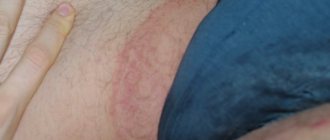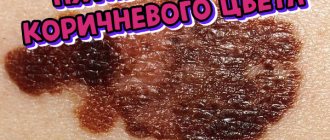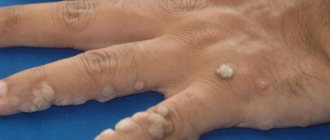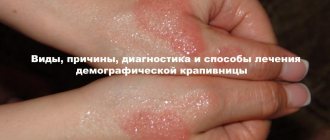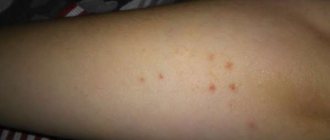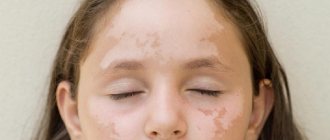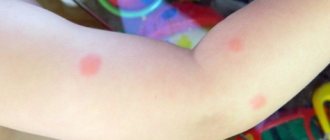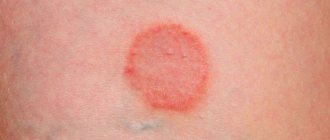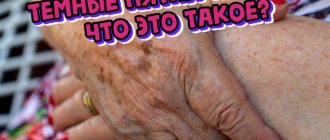Our skin is a large organ, it is a mirror of all our diseases. If any changes occur in the human body, then various spots, pimples, etc. may appear on our skin. Yellow spots on the skin are a serious reason to go to the doctor. If you have yellow spots on your skin, you need to urgently find out the cause of their appearance. There can be many reasons and only a specialist can help you with this. Yellow spots are rarely a symptom of a serious illness, but they shouldn't be ignored either.
Remember, you can start treatment yourself only if you have established the cause and the doctor has given you recommendations. The main rule for preventing yellow spots is giving up alcohol and smoking.
What is yellow pigmentation on the skin?
If a representative of the Caucasian phototype tans in the sun, his skin acquires a soft, chocolate shade. At the same time, the disease vitiligo can cover anyone, even the most naturally pale, with yellow and whitish spots.
When yellow spots appear on the skin, this phenomenon is called a facultative change in tissue structure. Such manifestations include the appearance of freckles and disruption of the uniform coloring of surface tissues.
Traditional medicine
You can get rid of pigmentation using pharmaceutical products:
- 1. Hydrogen peroxide 3%. It is applied pointwise to the spots several times a day until they lighten or completely disappear.
- 2. Zinc paste. Fights acne, wrinkles and has a whitening effect.
- 3. White clay. Masks made from it have a brightening effect and are suitable for sensitive skin.
In addition, a number of products from which masks and tonics are made have whitening properties. The most popular folk remedies are:
- 1. Cucumber mask. Fresh vegetables are finely grated, applied to the face and left for 15 minutes.
- 2. Cucumber lotion. Freshly squeezed juice is mixed with vodka in a ratio of 3:1. Wipe your face morning and evening.
- 3. Lemon lotion. Lemon juice is mixed with vodka in a 1:1 ratio. Do not use for sensitive and dry skin types.
- 4. Parsley tincture. Dried parsley is poured with boiling water in a ratio of 50 g per 200 ml of water, left for 6-8 hours, then filtered and wiped on the face twice a day. Keep refrigerated.
- 5. Milk and dairy products. The face is wiped with milk, and sour cream is used as a mask. This product will have a nourishing effect.
- 6. Lemon and honey mask. A tablespoon of honey is mixed with half a teaspoon of lemon juice. Apply for 15–20 minutes.
Yellow spots on the skin are an extremely unpleasant phenomenon that most often does not cause physical discomfort. At the same time, the occurrence of such formations interferes with normal life, making a person nervous.
In most cases, it is quite difficult to get rid of such manifestations. Let's try to find out what can cause stains? Yellow skin should be given due attention, since reluctance to identify the root cause of the phenomenon can result in the most unforeseen consequences.
Yellow spots on the skin: types
- Flat - are small neoplasms that have a rounded shape. Occurs on the soles and palms. They often form in older people due to excessive accumulation of cholesterol in the body and the development of atherosclerosis.
- Diffuse - yellow spots on the skin in the form of a massive accumulation of papules. In most cases, they become a side effect of diseases such as myeloma and leukemia.
- Intertriginous - is a hereditary disease. They often appear on the skin of people whose parents suffered from an excess of cholesterol in the body.
- Palmar - as in the previous case, such yellow spots on the skin are genetically determined. Typical for people whose bodies have disorders of lipoprotein metabolism.
- Eruptive - arise as a result of unhealthy lipid metabolism. Most often concentrated in the area around the eyes, on the eyelids, near the nostrils.
Yellowness is a sign of a serious illness
Yellowness of the palms can hide serious diseases, such as infectious jaundice can be caused by hepatitis B, A, C. In the acute form, the body temperature may rise, nausea, and abdominal pain may appear.
Another serious disease that causes yellow palms is anorexia nervosa. The disease is accompanied by a number of symptoms:
- fear of gaining weight;
- obsessive desire to lose weight;
- disturbances in a person’s consciousness about his own appearance (even with exhaustion of the body, a person considers himself very fat);
- rapid weight loss (15% of usual body weight);
- changes in skin color, yellowing of the palms;
- aggressiveness;
- drowsiness, fatigue.
This disease most often occurs in adolescents and women, which can be triggered by severe shock. The disease initially manifests itself in a sharp change in behavior and refusal to eat. Refusal of normal food provokes the development of other, more complex diseases. In this case, it is important to identify the problem in time and contact a specialist.
Causes
- minor subcutaneous hemorrhages;
- dermatological diseases;
- shocks, other mechanical effects on tissue;
- lipid metabolism disorders in the body;
- systemic illnesses.
What causes pale yellow spots? The skin tends to acquire a similar shade with the development of lichen versicolor and urticaria pigmentosa. It is these diseases that are initially not accompanied by absolutely no other symptoms. A person feels absolutely healthy for a long time until the disease begins to progress. Therefore, if yellow spots appear on the skin, you should immediately seek advice from an experienced dermatologist.
As for hemorrhages, which can cause yellow-brown spots on the skin, they are often caused by damage to the smallest vessels. At first, the spots may have a red tint, which over time changes to blue and later to yellow. Often, marks that arise as a result of mechanical action on tissue naturally disappear as a week passes as a result of the resorption of pockets of stagnant blood.
Systemic diseases such as lupus, Addison's disease, diabetes mellitus, and oncology can also lead to the appearance of yellow spots on the skin.
Yellow spots often signal improper functioning of internal organs: kidneys, liver, gall bladder. Manifestations of this type also occur with sexually transmitted diseases. They can also be caused by constant stress and lack of sleep. Among other things, a common cause of the formation of yellow spots is the wrong approach to skin care.
Symptoms
Skin changes are a sign whose nature can suggest the cause of what is happening. A comprehensive analysis of information received from the patient (complaints, anamnesis), combined with objective examination data, helps with this. When faced with yellowish or brown spots, it is important to determine not only their color, but also other parameters:
- Localization (throughout the body or in certain areas).
- Appearance (size, shape, edges, surface, structure).
- Dynamics of development (darkening or pallor, increase or decrease).
- Connection with certain factors (trauma, disease, pregnancy, insolation, medication, etc.).
In addition to skin elements, patients have other symptoms that create a complete clinical picture. The doctor evaluates not only local, but also systemic signs; he must conduct a thorough differential diagnosis to determine the cause of the spots. Whether they are physiological or indicate pathology - that is the most important question at the initial stage.
Pigment formations
Most often, brown spots are caused by the accumulation of melanin in the skin, and are considered a purely cosmetic defect. However, the structure of causes also includes systemic disorders affecting metabolic and endocrine processes. In Addison's disease, for example, there is insufficiency of the adrenal cortex, which causes a very diverse clinical picture:
- Weight loss.
- Muscle weakness, cramps.
- Dyspepsia (nausea, vomiting, diarrhea).
- Impaired skin sensitivity (paresthesia).
- Abdominal pain.
- Arterial hypotension.
- Cardiopalmus.
- Fatigue, anxiety, irritability.
Skin changes called Addison's melasma occur in areas most exposed to sunlight, i.e., in exposed areas of the skin. With the fulminant course of the disease, acute adrenal insufficiency develops, which poses a real threat to life.
In most cases, age spots are completely harmless, but they can also be caused by serious abnormalities in the functioning of the body.
Tinea versicolor
Pinkish-brownish spots are a symptom of pityriasis versicolor (pityriasis versicolor). This is a skin disease of fungal origin, belonging to the group of keratomycosis. The spots have the following characteristics:
- Most often localized on the back, chest, neck, shoulders and armpits.
- They are located isolated or tend to merge.
- Covered with small scales (pityriasis peeling).
- They don't tan in the sun.
The fungus affects only the stratum corneum of the epidermis. The process is often accompanied by itching and increased sweating, but no signs of inflammation are found.
Keratinoderma
Yellow spots on the hands (primarily the palms and soles) that occur with excessive consumption of orange vegetables - carrots, pumpkins, oranges - indicate a condition called keratinoderma. Provitamin A accumulates in the stratum corneum of the epidermis, secreted with sebum. This process does not produce any subjective symptoms, disappearing on its own after the diet is normalized.
Hemorrhagic diathesis
Increased permeability of the vascular wall and disturbances in the components of hemostasis (platelet or coagulation) lead to the emergence of a group of diseases known as hemorrhagic diathesis. They are accompanied by the release of red blood cells into the tissue. At first, the rash has a red tint, but on days 5-7 it fades, which is especially noticeable in the example of purpura or ecchymosis. First the elements turn brown, then green, and finally turn yellow. After them, pigmentation remains on the body.
In addition to skin manifestations, some diathesis may be accompanied by hemorrhages in soft tissues, joints, and internal organs. In turn, this leads to the development of a number of syndromes:
- Anemic (dizziness, pallor, decreased blood pressure, weakness).
- Abdominal (abdominal pain, nausea).
- Renal (dysuric disorders, hematuria).
- Articular (arthralgia, swelling).
Hemorrhagic diathesis causes chronic blood loss or can lead to acute conditions requiring emergency care. It all depends on the nature of the pathology and its clinical manifestations.
Hemoglobin, leaving the vascular bed during hemorrhagic diathesis, gradually “fades” in the skin, which leads to the appearance of yellow spots.
Treatment
If it is necessary to eliminate yellow spots on the skin, specialists often prescribe creams and solutions that contain a component called retin-A. The latter is an effective stimulator of cell regeneration. In addition, the substance reduces the damage that ultraviolet rays cause to healthy tissues.
If drug treatment does not give the expected results, you should use cosmetic methods. To begin with, you can try to eliminate yellow spots by resorting to a deep chemical peel. Laser correction allows you to complete what you started, which painlessly removes pigment manifestations from the skin and evenly lightens the affected areas.
Etiology
The appearance of yellow spots on the body may be due to the following etiological factors:
- pathological changes in the liver;
- hormonal disorders, in particular Addison's disease;
- using cosmetics that are not suitable for your skin type;
- allergic reactions;
- oncological diseases;
- lipid metabolism disorder;
- diabetes;
- some systemic diseases;
- dermatological diseases.
We should separately highlight the reasons for the manifestation of this symptom on the skin of a newborn baby:
- meconium entering the amniotic fluid before the birth of the child;
- systemic pathologies;
- infectious diseases.
If you have such a symptom, regardless of additional symptoms, you should consult a doctor and not self-medicate. The use of drugs or traditional medicine at your own discretion can lead not only to the development of complications, but also to a blurred clinical picture, which will complicate diagnosis.
Yellow palms of a child
Parents' concerns about their child are quite natural, especially when it comes to the baby's health. But there is no need to sow panic prematurely, because yellowed palms of a baby most often do not promise serious health problems.
A baby may have yellow palms for several reasons:
- hereditary feature;
- carotonemia - occurs as a result of excessive consumption of foods containing carotene. In the human body, carotenoids are processed into vitamin A. To eliminate the problem, you should change the baby’s diet.
But besides the harmless causes of yellow palms, there are other, more serious ones:
- hyperbilirubinemia - accompanied by a significant increase in bilirubin in the blood. The disease is manifested by a yellowish tint to the skin and a change in the color of the mucous membranes;
- liver problems;
- problems with bile.
To rule out complex diseases, take your baby to the pediatrician and get all the necessary tests.
Symptoms
In this case, there is no general clinical picture, since this is a symptom of a nonspecific nature. The manifestation of symptoms and the localization of yellow spots on the skin will depend on the provoking disease.
If the cause of this symptom is a dermatological disease, the patient may notice the following disorders:
- the formation of yellow spots on the scalp, limbs or body;
- rashes of multiple or single nature;
- yellow spots may turn brown;
- the rashes peel and may itch;
- over time, bubbles with liquid, plaques, ulcers or erosions may form at the site of the spots (depending on the type of disease);
- a general deterioration in health is possible.
If lipid metabolism is disrupted, yellow spots on the skin may be accompanied by the following changes:
- rashes are mainly localized on the back, chest and abdomen;
- gradually the spots increase in size and group together.
In this case, relief, itching and peeling are not observed.
This disease does not pose a significant threat to health, but consultation with a doctor is required.
If the etiology of yellow spots on the skin of the face is a systemic disease, then the following clinical picture may occur:
- swollen lymph nodes;
- muscle pain and weakness;
- feeling of lethargy, drowsiness;
- chronic fatigue syndrome;
- hair loss;
- swelling of the lower extremities;
- rashes of various types;
- increased sensitivity to ultraviolet rays;
- deterioration in the functioning of the gastrointestinal tract;
- exacerbation of chronic diseases;
- general deterioration of health.
The appearance of yellow spots may indicate the development of diabetes mellitus, which is characterized by the following clinical picture:
If these signs appear, you should immediately seek medical help rather than self-medicate.
If the cause of yellow spots on the skin of the hands or face is Addison's disease, then the following symptoms may appear:
- dizziness;
- increased sensitivity to cold;
- weakness, fatigue;
- loss of appetite, resulting in weight loss;
- low pressure;
- disruption of the functioning of the gastrointestinal tract, which can manifest itself in the form of nausea, vomiting, changes in stool consistency, and abdominal pain.
If you have the symptoms described above, you should consult a doctor and not self-medicate.
Urticaria pigmentosa (mastocytosis)
In some forms of this disease, light yellow or yellowish-brown spots may appear, which can be isolated or located in groups, forming flat nodules up to one and a half centimeters in diameter.
The nodules have a dense consistency, with a smooth surface similar to an orange peel. It occurs in men and women, and children can get sick. The dermis may thicken and the skin folds may deepen. The affected areas are located in the inguinal folds, on the upper and lower extremities, face, and torso. The process lasts for many years, exacerbations occur due to friction with clothing or after thermal procedures.
Diagnostics
The choice of methods for diagnosing the underlying disease in the presence of such a symptom will depend on the current clinical picture and the medical history collected by the doctor during the initial objective examination.
To make a diagnosis, the following laboratory and instrumental methods can be prescribed:
- general blood and urine tests;
- detailed biochemical blood test;
- blood sugar test;
- tumor marker tests;
- immunogram;
- Ultrasound of internal organs;
- gastroenterological studies;
- CT;
- MRI.
Based on the examination results, the doctor can determine the etiology of the symptom and prescribe the correct course of treatment.
Treatment
There is no general treatment program; therapeutic measures will depend on the established disease. In most cases, conservative therapy is carried out. If the cause of the symptom is determined to be a gastroenterological disease, in particular liver pathology, then a certain dietary table must be included in the treatment.
There are no targeted methods of prevention, since this is not a separate disease, but a symptom of a nonspecific nature. Self-medication is strongly not recommended; you should consult a doctor.
Quite common nowadays are questions about why yellow spots appear on the human body and what they may indicate. That is why we will now try to understand this in more detail.
A person’s skin is considered a mirror of his health, because a considerable number of diseases and pathological processes are manifested by changes in his condition. Most often, various spots appear on the skin. In this case, it is recommended to seek help from a doctor as soon as possible, because only he can determine the exact cause of their appearance and prescribe adequate treatment.
False jaundice
If, during a visit to a therapist, you complained about yellow palms, the following entry may appear in your medical record: “False jaundice.” What does it mean? First of all, there is no need to be scared. Unlike real jaundice, this disease does not threaten you in any way: with false jaundice, a person only develops external symptoms of the disease (in particular, the color of the skin changes). The internal organs are not affected at all. It's likely that your yellow skin is due to eating too many carrots and oranges (perhaps you're on a special diet?). Carotene accumulates in the blood.
Reasons for formation
Yellow spots on the skin can appear as a result of various pathological conditions in the human body, which is what we will talk about now.
Hemorrhage
Hemorrhage is a hemorrhage that is formed as a result of a violation of the integrity of blood vessels. The tissues become saturated with blood, which provokes the appearance of red spots on the skin, which change color over time and become yellow.
Diseases of dermatological origin
This could be lichen, urticaria and other diseases. Their main symptom is the formation of yellowish spots. In most cases, young children suffer from these pathological conditions, but their occurrence in adults is no exception.
Children develop pink spots that fill with exudate over time. After healing, yellow-brown marks remain on the skin. In adults, yellow spots appear on the face, arms, stomach and spread throughout the body, their diameter reaches 5 mm.
Please note that diseases can develop as a result of:
- mechanical irritation of the skin;
- influence of ultraviolet radiation;
- use of medications;
- influence of cold;
- psychological overload;
- consumption of certain foods.
Orange spots on the skin may be a symptom. both the systemic form of the disease (when internal organs are damaged) and the skin form.
Systemic diseases
Changes in the skin can appear with Addison's disease, lupus erythematosus, and diabetes mellitus.
What other diseases cause a yellowish complexion and body, read the link https://skinadvice.ru/zheltiy-tsvet-kozhi.html
lupus erythematosus
This pathological condition can have two forms: chronic and discoid. In the vast majority of cases, it is diagnosed in representatives of the weaker half of humanity aged 20 to 45 years. It is characterized by the appearance of a yellow spot on the skin of the face, namely on the border of the lips. The main reasons for its formation are:
- allergic reaction to cold or sunlight;
- hereditary predisposition;
- disruption of the functioning of the endocrine system;
- use of certain types of medications;
- the influence of long-term stressful situations;
- diseases of infectious origin.
This pathological condition requires mandatory treatment, because yellow spots on the skin of the face do not beautify a person.
Diabetes
The disease occurs as a result of metabolic disorders in the body. Due to the fact that the disease has two types, symptoms may vary. Usually appear:
- yellow spots on the skin of the legs;
- feeling of weakness;
- blurred vision;
- feeling of thirst;
- change in body weight;
- numbness of the lower extremities.
It is precisely due to the fact that systemic diseases are manifested by changes in the skin that they can be diagnosed as early as possible, and this in turn will minimize the negative consequences for the entire body.
Lipid metabolism disorders
Yellow spots on the stomach, back and throughout the body may also indicate a lipid metabolism disorder; they are also called xanthomas. They have their own classification:
- flat xanthomas - diagnosed in persons with a history of cholesterol metabolism disorders;
- diffuse - quite often cause the formation of leukemia;
- intertriginous - yellow spots appear on the skin of the hands, indicating high cholesterol levels;
- volcanic - these yellow spots are localized on the head in adults, the favorite localization is the eyelids;
- eruptive - small yellow spots on the legs, they have clear boundaries and are localized on the buttocks and thighs.
A yellow spot on the body, especially if it is prone to discoloration, can degenerate into a malignant neoplasm. The same can be said about moles, especially if they increase in size.
Tinea versicolor
This pathological condition must be understood as a fungal disease that affects the skin. It manifests itself in the formation of yellow spots on the chest, back, upper and lower extremities. Please note that their color may change to brown.
Yellow palms - cause and remedy
Articles › Causes of yellow palms and yellowing of the skin
Changes in skin color definitely indicate problems with the human body. Today, we will talk about why palms turn yellow and how to get rid of it.
Reasons for changing shade on the skin of the palms
Our body is a coherent system that depends on the work of all organs. If at least one of the organs performs its function poorly, the system malfunctions and the body indicates in possible ways the existence of a problem - in our case, these are yellow palms.
The reason for the appearance of yellowness on the palms may be a dysfunction of the liver or choleretic bladder. Processes harmful to the body can be provoked by the following diseases:
- cirrhosis of the liver;
- inflammatory processes in the choleretic ducts;
- inflammatory processes in the gallbladder;
- hepatitis;
- gallstone disease.
Yellow hands and fingers
But you shouldn’t immediately fall into despair, because yellow palms can indicate “false jaundice.” This disease does not pose a particular danger to the body, since only external signs of the disease appear, and the functioning of the internal organs is not impaired.
Another thing is if you are worried not only about the yellowness of your hands, but also about accompanying symptoms, such as abdominal pain, painful sensations when urinating, etc., without hesitation, you should consult a doctor to conduct a full examination.
The effect of carotene on skin color
Excessive consumption of certain fruits, vegetables or root vegetables can also cause yellow palms. Review your diet, maybe lately you have become interested in eating carrots, pumpkin, squash or tangerines.
When consuming products containing keratin, most of the substance is absorbed into the blood and distributed throughout the human body. Due to the fact that the skin of the palms contains less of the coloring substance melanin, an excessive amount of keratin in the body may manifest itself as yellowish palms.
Yellowness is a sign of a serious illness
Yellowness of the palms can hide serious diseases, such as infectious jaundice can be caused by hepatitis B, A, C. In the acute form, the body temperature may rise, nausea, and abdominal pain may appear.
Another serious disease that causes yellow palms is anorexia nervosa. The disease is accompanied by a number of symptoms:
- fear of gaining weight;
- obsessive desire to lose weight;
- disturbances in a person’s consciousness about his own appearance (even with exhaustion of the body, a person considers himself very fat);
- rapid weight loss (15% of usual body weight);
- changes in skin color, yellowing of the palms;
- aggressiveness;
- drowsiness, fatigue.
This disease most often occurs in adolescents and women, which can be triggered by severe shock. The disease initially manifests itself in a sharp change in behavior and refusal to eat. Refusal of normal food provokes the development of other, more complex diseases. In this case, it is important to identify the problem in time and contact a specialist.
Yellow palms due to jaundice
Jaundice is a disease characterized by the appearance of a yellowish tint on the skin and mucous membranes. Yellow spots are especially noticeable on the palms, lower part of the tongue, and also on the eyeballs.
To understand the causes of jaundice, you should know that yellowing of the skin is caused by an increase in bilirubin, which is produced as a result of the breakdown of another component of the blood - hemoglobin. Bilirubin is divided into two types:
- indirect bilirubin occurs immediately after the breakdown of hemoglobin;
- direct bilirubin is produced by the liver after a series of biochemical reactions.
Having learned about the peculiarities of bilirubin production, we can move on to our main question - why do hands turn yellow during jaundice. First of all, it should be said that jaundice comes in several types:
- hemolytic - the disease occurs as a result of the accelerated process of hemoglobin breakdown. As a result, an excessive amount of indirect bilirubin is produced, which the liver does not have time to process directly;
- hepatic – a disease caused by damage to the body’s main filter, the liver. There may be several reasons: drug, alcohol poisoning, toxic effects on the body, viral hepatitis, etc.;
- cholestatic - the disease occurs due to blockage of the bile ducts. Closure of the bile ducts can occur in the presence of a tumor or stones.
Do not try to treat jaundice on your own, even if you have already encountered a similar disease. Many online forums contain information about the treatment of this disease with diuretic decoctions. But if jaundice is caused by stones in the gallbladder or its ducts, such treatment will worsen the situation several times.
Yellow palms of a child
Parents' concerns about their child are quite natural, especially when it comes to the baby's health. But there is no need to sow panic prematurely, because yellowed palms of a baby most often do not promise serious health problems.
A baby may have yellow palms for several reasons:
- hereditary feature;
- carotonemia - occurs as a result of excessive consumption of foods containing carotene. In the human body, carotenoids are processed into vitamin A. To eliminate the problem, you should change the baby’s diet.
But besides the harmless causes of yellow palms, there are other, more serious ones:
- hyperbilirubinemia - accompanied by a significant increase in bilirubin in the blood. The disease is manifested by a yellowish tint to the skin and a change in the color of the mucous membranes;
- liver problems;
- problems with bile.
To rule out complex diseases, take your baby to the pediatrician and get all the necessary tests.
Yellow palms in an adult
Palms with a yellow or orange tint in an adult may indicate the following problems:
- Nicotine addiction. In almost all heavy smokers, the color of the skin, teeth and nail plates changes, but the internal organs suffer the most. Frequent smoking is a provocateur of diseases such as periodontal disease or cirrhosis of the liver;
- Cirrhosis of the liver. The disease manifests itself as yellowing of the palms and soles of the feet. The patient may also suffer from constant nausea, dry mouth, fatigue, and general exhaustion of the body.
Most people are in no hurry to get examined, arguing that they are constantly busy with problems or are simply afraid to hear the shocking truth, thereby worsening the situation. It is important to understand that the sooner a person with a serious illness begins treatment, the greater his chances of recovery.
Other causes of yellowness
There are other, less common causes of yellow palms:
- in some, yellowness appears as a result of damage to the body by worms;
- long-term or improper use of potent medications can cause changes in the skin of the hands;
- with alcohol poisoning, skin color may change;
- Age-related changes in the human body can also cause yellowness.
How to eliminate yellow spots
Before you begin to eliminate yellow spots, you need to accurately determine the cause of their appearance. To get rid of yellow palms you need to:
- If the reason for poor skin color lies in an unhealthy lifestyle, namely: smoking and drinking alcohol, then you should start by giving up bad habits. After a person stops drinking and smoking, the body is gradually cleansed and freed from toxins, and the skin color gradually returns to normal. You can also use entire complexes to cleanse the body, after consulting with your doctor;
- yellowness from excess carotene will go away on its own if you create the right diet;
- jaundice of the physiological type (the disease manifests itself immediately after the birth of the baby) goes away after a few weeks, but the local pediatrician must monitor the situation. In some cases, it is recommended to use phototherapy - exposing the newborn to light from a fluorescent lamp. The procedure allows you to destroy unnecessary bilirubin much faster and remove it from the body. If the jaundice does not go away within several weeks, the pediatrician prescribes medications to the baby in the form of droppers;
- to get rid of yellowness, which is provoked by pathologies of the bile ducts or liver, only complex therapy under the supervision of a doctor is necessary. As a rule, in such cases, a specialist prescribes potent medications, so the severity of external symptoms decreases very quickly. Depending on the situation, treatment of the patient may consist not only of medications and procedures, but also include surgery.
Leave a review (3)
Source: https://portal-pacienta.ru/zheltye-ladoni
Remedies
When diagnosing xanthomas, first of all, you need to monitor your diet. It is recommended to avoid drinking alcoholic beverages, dishes and foods containing large amounts of animal fats. Particular attention should be paid to the level of cholesterol in the blood; if it increases, it is recommended to take medications prescribed by the doctor.
If the xanthomas are large and cause a cosmetic defect, they may need to be removed. This can be done using:
- electrocoagulation;
- laser;
- surgical intervention.
For treatment to be effective, it is necessary to determine the root cause of xanthomas and eliminate it. After this, they can disappear on their own without outside help.
Prevention
It's no secret that preventing the onset of a disease is much easier than treating it. The same applies to our case.
In order to prevent the formation of yellow spots, it is recommended:
- Avoid prolonged exposure to direct sunlight.
- Use special skin protection products from ultraviolet radiation.
- If they appear, avoid eating fatty animal foods.
- To refuse from bad habits.
To summarize, I would like to note that, despite the fact that yellow spots on the body are not evidence of serious illnesses, they still should not be ignored. Even if they do not cause discomfort, it is necessary to consult a doctor for advice and decide how this pathological condition will be treated. This is explained by the fact that such changes on the skin, especially on open areas of the body, do not look at all aesthetically pleasing.
What are pigment spots
Before you start figuring out how to get rid of stains on your hands, you need to figure out where the so-called senile black marks come from. As a rule, the cause of spots is increased melanin in certain areas of the skin. The hormone responsible for the color of the skin, hair and eyes forms small dots when exposed to sunlight. Brushes are exposed to the sun the most. The deficiency can be removed using cosmetics, traditional methods, and special creams.
Red spots on hands
Unlike brown spots, a red spot on the hand can be either completely harmless or serve as a harbinger of disease. Urticaria is an allergy that spreads from the fingers and causes peeling and redness of the skin. The appearance of red marks is not a pigment formation, but is directly related to blood vessels, liver and heart diseases. Sometimes in the initial stages this is how vasculitis or hemangioma manifests itself. The latter ones in the photo resemble stars.
Yellow spots on hands
Appearing yellow spots on the hands are a reason to consult a gastroenterologist as soon as possible. The appearance of marks is not a disease, but the yellow color makes you think about problems with the liver, stomach, or intestinal dysfunction. Pigmentation of the hands appears with the onset of the disease: cholecystitis, liver failure, intestinal dysfunction. The gastrointestinal tract and other human organs are a single whole, so do not try to solve the problem solely with cosmetics.
Brown spots on hands
Why do pigment spots appear on my hands? Brown spots on the hands of a young woman are alarming and serve as a reason to go to the doctor: there is a risk of developing a dangerous disease - melanoma. People with hormonal imbalances, after an allergy attack and after excessive exposure to ultraviolet rays should be especially careful. In old age and old age, a violation of melanin production occurs in many people; it is a variant of the norm. Marks are corrected with the help of nutritious decoctions, creams, other procedures and unconventional remedies.
